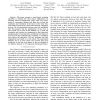Free Online Productivity Tools
i2Speak
i2Symbol
i2OCR
iTex2Img
iWeb2Print
iWeb2Shot
i2Type
iPdf2Split
iPdf2Merge
i2Bopomofo
i2Arabic
i2Style
i2Image
i2PDF
iLatex2Rtf
Sci2ools
ICRA
2005
IEEE
2005
IEEE
Metric-Based Scan Matching Algorithms for Mobile Robot Displacement Estimation
— This paper presents a metric-based matching algorithm to estimate the robot planar displacement by matching dense two-dimensional range scans. The contribution is a geometric distance that takes into account the translation and orientation of the sensor at the same time. This result is used in the two steps of the matching - estimation process. The correspondences between scans are established with this measure and the minimization of the error is also carried out in terms of this distance. As a result, the translation and rotation are compensated in this framework simultaneously. In fact, this is the contribution with respect to previous work that addressed only translation or translation and rotation but separately. The new technique has been implemented and tested on a real vehicle. The experiments illustrate how it is more robust and accurate than prior techniques. At the end of the paper, we give an extension of our distance measure to 3D range-data matching problems.
ICRA 2005 | Metric-based Matching Algorithm | Robot Planar Displacement | Robotics | Two-dimensional Range Scans |
Related Content
| Added | 25 Jun 2010 |
| Updated | 25 Jun 2010 |
| Type | Conference |
| Year | 2005 |
| Where | ICRA |
| Authors | Javier Minguez, Florent Lamiraux, Luis Montesano |
Comments (0)

